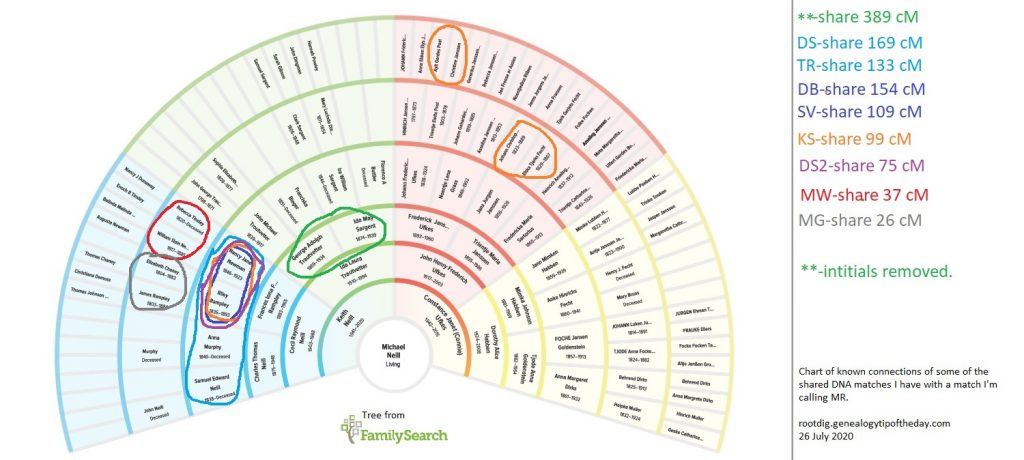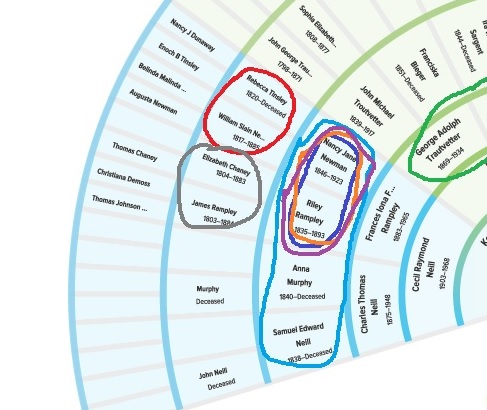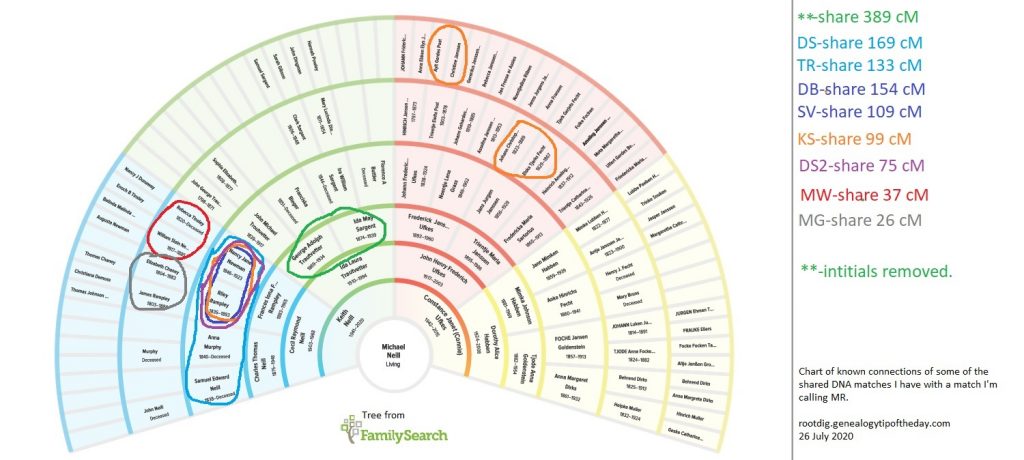A recent new match in my AncestryDNA test results struck my curiosity. Of course the match had no attached tree but we had several shared matches. That’s where the confusion began.
I have determined the most recent common ancestors for almost thirty of my closest DNA matches at AncestryDNA and have a significant number of the next fifty or so determined as well.
This match was one with whom I shared 72 cM of DNA and I was curious to see if I could get an idea of where in my genealogy this match likely fit. Often I can get an idea by looking at the shared matches. This time it was a little more confusing. We’ll refer to this match as “MR.”
The closest shared match I had with MR was a first cousin of my father. But when I looked down the list of shared matches there were no other members of that first cousin’s family. Most of the known other shared matches were related to my father as well. Except for the one who was a descendant of two sets of maternal ancestors.

I had an idea of what was going on, but decided instead of making a spreadsheet to use a pedigree chart to plot out the results in a slightly different way.
I circled the most recent common ancestors I had with each match I shared with MR. Color coding these seemed helpful as well. Only nine of these shared matches have been included in the chart.
Based upon the chart and what I already knew about my family, I was reasonably certain how this match was connected to me.
My Grandma Neill
None of the shared matches except one was a descendant of my grandmother’s parents–George and Ida Trautvetter. I have one shared match who is also a descendant of this couple and at least thirty who are descendants of at least two of George and Ida’s grandparents. Since this was the only one, I decided that the fact the match was shared with MR was very likely due to them having a genealogical relationship with each other that they did not share with me.
My Granddad Ufkes
One of the shared matches with MR was a known descendant of two sets of my maternal grandfather’s ancestors. That match (KS–with whom I share 99 cM of DNA) actually shares three separate sets of “most recent common ancestors” with me. The maternal connection I share with KS does not appear to be connection I share with MR. KS was the only shared match with MR that was also a known descendant of the two maternal ancestral couples of mine as shown on the chart. No other determined shared matches descended from either of these couples. Both of those couples have numerous known descendants who are shared DNA matches of mine at AncestryDNA–but this match is the only one MR and I share. That also suggests that MR has a connection to KS that they do not share with me.
My Grandpa Neill
Looking at the pedigree locations of the known shared matches with MR, it seemed that the connection was actually through my Grandpa Neill.
Two of the matches shared with MR were descendants of all four of my Grandpa Neill’s grandparents, but were not descendants of my Grandpa Neill’s parents. That’s because a sibling of my great-grandpa Neill married a sibling of my great-grandma Neill and the matches descend from that marriage.

There are approximately fifteen of my DNA matches who are connected to me through Samuel and Anna (Murphy) Neill that are not descendants of the Rampley family. None of those Neill matches of mine are shared matches with MR.
Based on the picture I created and the number of shared matches who were descendants of Riley and Nancy (Newman) Rampley, I’ve decided that is where this person likely connects to me. AncestryDNA suggests the person is a 4th to 6th cousin.
Using the pedigree chart was a nice visual. There are a few ways I would improve it in the next iteration, but it was easier to view the connections than if I had simply put the information in a table or spreadsheet.
Reminders:
- Pedigree charts can serve a variety of purposes.
- Individuals can be related to you and each other in different ways.
- Working up all your matches–even ones on the families you are not interested in–will help in your analysis of DNA test results.


No responses yet